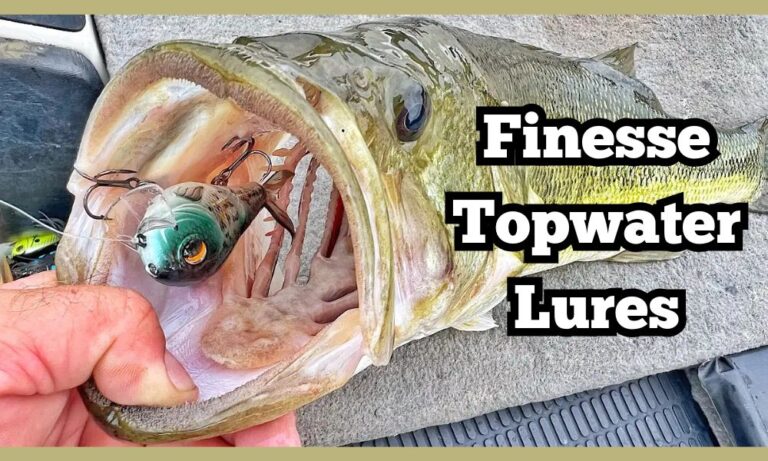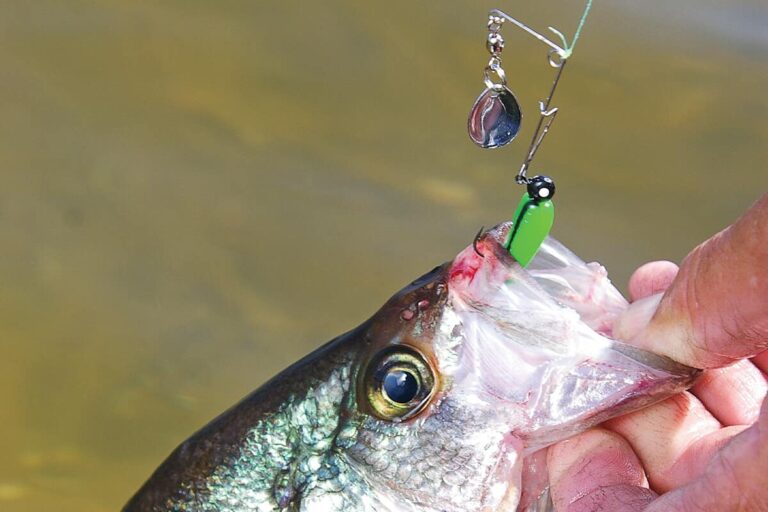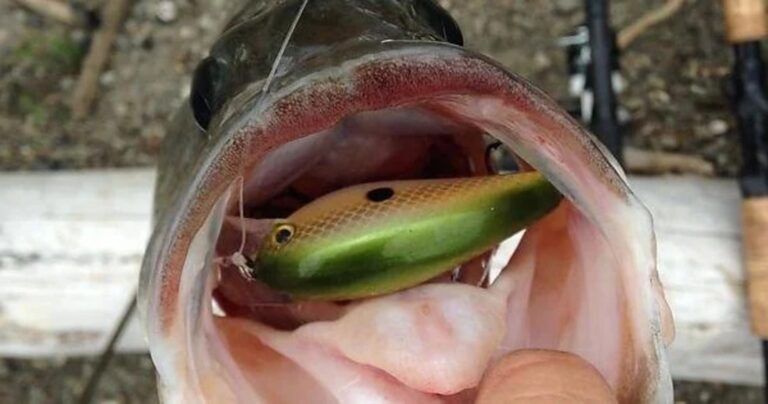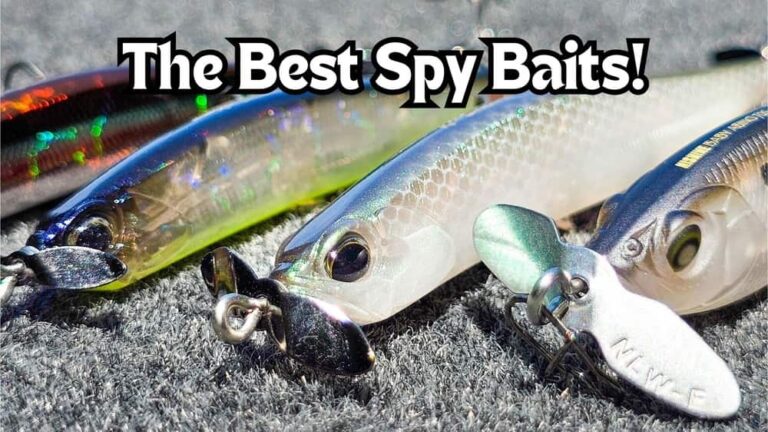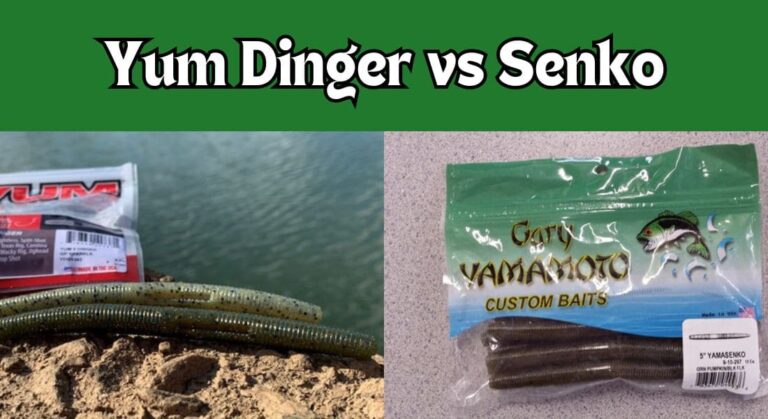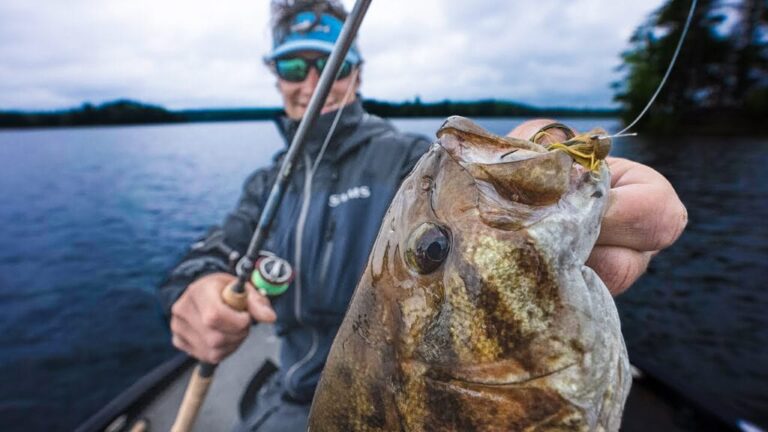Jig Fishing for Bass: Guide to Bass Fishing with Jigs
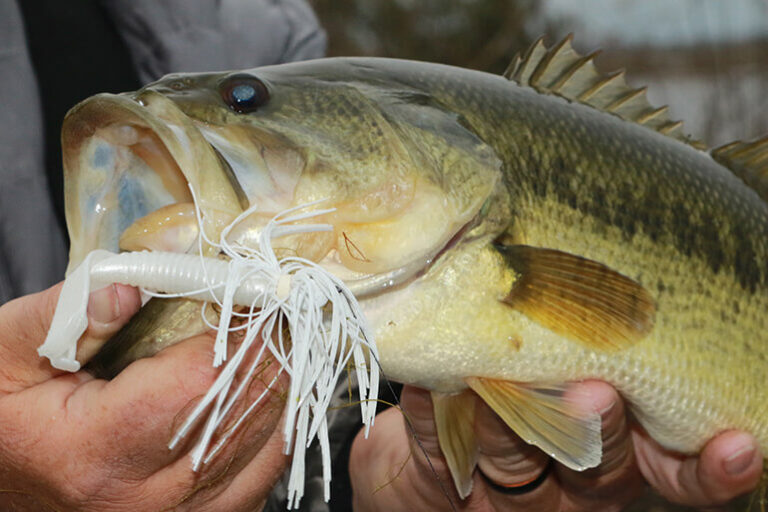
Jigs are without a doubt the most popular bass lure out there. Every angler fishes a jig year round.
Jigs are incredibly versatile and unique lures that allow you to catch bass no matter the weather, time of year, or water conditions.
Jigs can be hard to master, but once you have, they are the most powerful lure you can add to your arsenal.
What are Bass Jigs?
Jigs consist of a weighted head, hook, weed guard, and skirt made of materials like silicone or rubber.
These jigs don’t really look exactly like anything that a bass might eat. But they look a little bit like everything a bass might eat.
Jigs allow you to mimic any type of bass forage while being able to fish any type of water depth, cover, or clarity.
Advantages of Bass Jigs
Jigs offer several advantages that make them a popular choice among anglers. Here are some key advantages of using jigs for fishing:
- Versatility: Jigs are highly versatile lures that can be used in a wide range of fishing conditions. Whether you’re fishing in shallow waters, deep structures, or heavy cover, jigs can be effective in attracting bass.
- Realistic Presentation: Jigs are designed to imitate natural prey, such as crawfish, baitfish, or other aquatic creatures. The skirt and trailer combination creates a lifelike appearance and enticing movement that can trigger a bass’s predatory instincts.
- Targeting Big Bass: Jigs are known for their ability to attract larger, trophy-sized bass. The realistic presentation and larger profile of jigs make them a preferred choice when targeting bigger fish.
- Versatile Retrieval Techniques: Jigs can be fished using a variety of retrieval techniques, allowing anglers to adapt to different situations. Techniques like casting and retrieving, flipping and pitching, or jigging in deep waters can all be effective with jigs.
- Fishing in Cover: Jigs excel in fishing areas with heavy cover, such as weeds, brush piles, or submerged structures. The weedless design and compact profile of jigs allow them to navigate through cover without getting snagged easily.
- Customization: Jigs offer customization options by allowing anglers to change the skirt color, trailer type, or modify the jig’s appearance to match specific fishing conditions and mimic preferred prey.
- Year-Round Effectiveness: Jigs can be productive throughout the year, adapting to seasonal changes and varying water conditions. From spring to fall, jigs remain a reliable choice for bass fishing.
Types of Jigs
There are a wide variety of jigs that each specialize in one specific fishing style.
At first glance, they might all look the same, so let’s break each one down so you know which to tie on.
1. Football Jigs
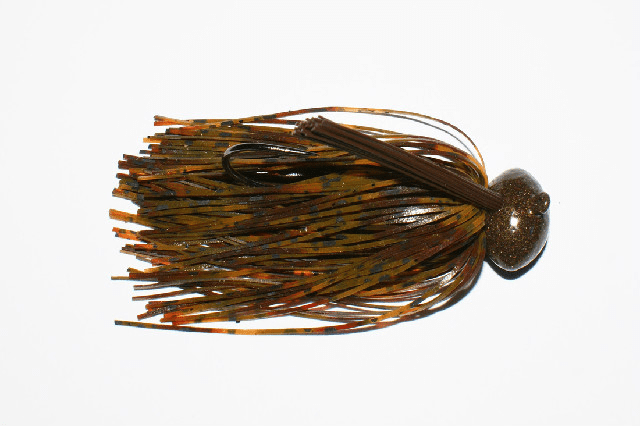
Football jigs are a popular type of bass fishing jig known for their unique head design, which resembles the shape of a football.
This wide jig head serves two main purposes. First, it helps keep the jig from getting wedged in between rocks.
Other, pointy jig heads will squeeze into the rocks and get stuck, but the football head is much better at avoiding this.
Second, this shape causes the jig to rock back and forth a bit and displace more water. This helps bass find the lure in deeper, darker water.
When to Use Football Jigs
Football jigs are particularly effective when fishing in rocky or hard-bottom areas. They excel in situations where the bait needs to crawl and bounce along the bottom, mimicking a crawfish or other bottom-dwelling prey. Some ideal scenarios for using football jigs include:
- Rocky Structures: Football jigs shine when fishing around rocks, boulders, or rocky ledges. The flat bottom of the jig head helps it navigate through rocky terrain without getting easily snagged.
- Deepwater Fishing: When targeting bass in deeper water, football jigs are an excellent choice. Their heavier heads allow for better control and help you reach greater depths efficiently.
- Cold Water Conditions: Bass tend to move slower and hug the bottom in colder water temperatures. Football jigs, with their dragging action along the bottom, can entice sluggish bass to strike even in chilly conditions.
How to Use Football Jigs
Using football jigs effectively involves employing the right techniques and presentation. Here are a few tips to maximize your success with football jigs:
- Choose the Right Weight: The weight of the football jig depends on the depth you’re fishing and the current conditions. Heavier jigs work well in deeper water, while lighter ones are suitable for shallow areas.
- Cast and Drag: Make a long cast and allow the jig to sink to the bottom. Once it touches down, slowly drag it along the bottom, imitating the movement of a crawfish. Maintain contact with the jig by feeling for any subtle bites or changes in resistance.
- Vary the Speed: Experiment with the speed of your retrieve. Sometimes a slow, dragging retrieve works best, while other times a slightly faster crawl can trigger a reaction bite.
- Pay Attention to Structure: Focus on fishing around rocks, drop-offs, or any other structure where bass might be hiding. Allow the football jig to bump into the rocks or come into contact with structure, as this can trigger strikes from nearby bass.
- Consider Trailer Options: Pair your football jig with an appropriate trailer to enhance its appeal. Chunk-style trailers or crawfish imitations work well in imitating the natural movement of prey.
2. Flipping Jigs

Flipping jigs are a specialized type of bass fishing jig designed for close-quarters combat.
With their compact profile and weedless design, flipping jigs excel in dense cover and offer a unique advantage in specific fishing situations.
Being able to slide right in and out of heavy cover allows you to pick apart high percantage areas without getting up.
When to Use Flipping Jigs
Flipping jigs are ideal when fishing in heavy cover, such as thick vegetation, brush piles, or submerged structure. They shine in scenarios where precision and accuracy are crucial. Consider using flipping jigs in the following situations:
- Heavy Vegetation: When fishing in dense weed beds or mats, flipping jigs are a go-to choice. Their weed guards and streamlined design allow them to penetrate through vegetation without getting snagged, making them perfect for flipping into pockets or gaps.
- Brush Piles and Docks: Flipping jigs work exceptionally well when targeting bass around brush piles, submerged trees, or docks. Their ability to navigate tight spaces and effectively present a baitfish or crawfish imitation increases your chances of enticing strikes.
- Thick Cover: If you encounter submerged logs, laydowns, or other forms of heavy cover, flipping jigs can excel in getting to those hard-to-reach areas where bass seek shelter.
How to Use Flipping Jigs
To make the most of flipping jigs, it’s important to employ proper techniques and presentations. Here are some tips to help you use flipping jigs effectively:
- Choose the Right Jig and Trailer: Select a flipping jig with a sturdy hook, weed guard, and compact profile. Pair it with a trailer that matches the forage in the area, such as a creature bait or a bulky crawfish imitation.
- Short, Precise Casts: Flip or pitch the jig directly into target areas, aiming for pockets in vegetation, gaps in cover, or specific structure. Accuracy is key when using flipping jigs to present the lure precisely where the bass are hiding.
- Controlled Descent: Once your jig reaches the target area, allow it to sink naturally and descend through the cover. Maintain a tight line and be prepared for any subtle strikes or changes in weight, as bass often hit flipping jigs on the initial fall.
3. Swim Jigs

Swim jigs are fished much faster and aggressively than all other jigs. Swim jigs have a pointed jig head with the eye hole at the very front of the lure.
This design allows the jig to be reeled in and hopped through the water without turning on it’s side or losing it’s action.
Swim jigs are fished similarly to a spinnerbait. Obviously there aren’t any blades on the swim jig, but you still reel it and hop it very quickly through the middle of the water column.
The advantage of the swim jig is that it still has the thick weed guard, so it can be fished in very thick cover.
When to Use Swim Jigs
Swim jigs are particularly useful in situations where bass are actively feeding and chasing baitfish. Consider using swim jigs in the following scenarios:
- Open Water: Swim jigs are perfect for fishing in open water, such as expansive flats, points, or along weed edges. They allow you to cover water efficiently and imitate the movement of baitfish that bass are actively targeting.
- Shallow Water: When bass are shallow and feeding near the surface, swim jigs can be highly effective. Their ability to swim just below the water’s surface imitates the action of baitfish, enticing bass to strike.
- Active Feeding Periods: Use swim jigs during periods of increased bass activity, such as dawn, dusk, or when bass are actively chasing schools of baitfish. This is when bass are more likely to react to a fast-moving, swimming presentation.
How to Use Swim Jigs
To maximize your success with swim jigs, it’s essential to employ the right techniques and presentation. Here are some tips on how to effectively use swim jigs:
- Choose the Right Jig and Trailer: Opt for a swim jig with a sleek and streamlined design, as well as a matching trailer. The trailer should imitate a swimming baitfish or have a paddle-tail for added action.
- Cast and Retrieve: Make a long cast to cover a larger area of water. Once the jig hits the water, start a steady and consistent retrieve, imparting a swimming motion to the jig. Vary your retrieve speed to determine what triggers the most strikes.
- Use Rod Movement: Incorporate rod movement to enhance the action of the swim jig. A subtle twitch or lift of the rod tip can create a darting or erratic movement, imitating a wounded or fleeing baitfish.
- Target Structure and Cover: Cast your swim jig near structure, such as submerged grass, brush piles, or rocks. Bass often hide near these areas, waiting for an opportunity to ambush passing prey.
- Pay Attention to Depth: Adjust the weight of your swim jig to target different depths. Heavier jigs allow for deeper presentations, while lighter ones work well in shallower water.
4. Finesse Jigs
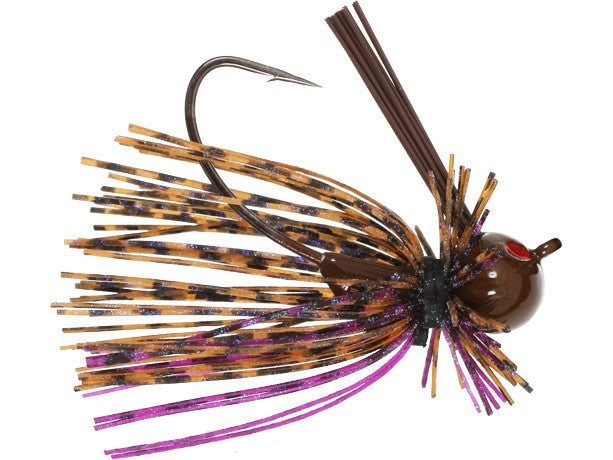
Finesse jigs are much smaller and lighter jigs. These jigs excel for smallmouth bass or when bass are a bit more finicky.
Sometimes, bass don’t want to commit to the big, bulky profile of traditional jigs. This often happens during the winter season or a cold front.
If bass seem to be in this mood, switch to a finesse jig. You will still be able to fish all types of cover, but with a finesse presentation.
When to Use Finesse Jigs
Finesse jigs are best used when bass are in a more cautious or inactive feeding mood, such as during post-frontal conditions or when the water is clear and calm. Consider using finesse jigs in the following situations:
- Clear Water: When fishing in clear water conditions where bass can see lures more easily, finesse jigs can be highly effective. Their compact size and realistic appearance mimic natural prey and entice bass to strike.
- High-Pressure Lakes: In heavily-fished lakes or waters where bass have seen a lot of traditional presentations, finesse jigs can be a game-changer. The subtle and finesse-oriented approach can trigger strikes from wary or educated bass.
- Cold Water or Post-Frontal Conditions: During colder water temperatures or after a front has passed through, bass tend to become more lethargic. Finesse jigs allow for a slower, more methodical presentation that matches the bass’s decreased activity level.
How to Use Finesse Jigs
To effectively use finesse jigs, it’s important to employ the right techniques and finesse-oriented presentations. Here are some tips to help you make the most of finesse jigs:
- Choose the Right Jig and Trailer: Opt for finesse jigs with a smaller profile, lighter weight, and a realistic-looking skirt. Pair them with a small, finesse-style trailer, such as a small grub or a slender soft plastic worm.
- Light Line and Sensitive Rod: Use light line, such as fluorocarbon or braided line with a fluorocarbon leader, to increase sensitivity and maintain a more natural presentation. A sensitive rod with a light or medium-light power rating will allow you to detect subtle bites.
- Delicate Casting and Retrieval: Make accurate casts to specific targets, such as near structure, drop-offs, or pockets. Allow the finesse jig to sink to the desired depth, and then use a slow and subtle retrieve, imparting small twitches or hops to mimic a crawling or hopping baitfish or crawfish.
- Bottom Bouncing: Finesse jigs are often effective when bounced or dragged along the bottom. Maintain contact with the jig by periodically lifting the rod tip to feel for any subtle strikes or changes in resistance.
Also Read: Micro Jig Fishing
Choosing the Right Fishing Jig
First things first, consider the water conditions. Is it clear or murky? Is there heavy vegetation or rocks? These factors can influence the type of jig you need.
For clear water or areas with sparse cover, finesse jigs with a smaller profile can work wonders.
On the other hand, if you’re dealing with thick vegetation or rocky structures, football jigs or flipping jigs are your go-to options.
Next, take into account the seasonal variations. Bass behavior changes throughout the year, so your jig choice should adapt accordingly.
During the spring and fall, when bass are more active and chasing prey, swim jigs can be highly effective. In colder months or post-frontal conditions, finesse jigs with a slow and subtle presentation often get the job done.
Consider the targeted bass species as well. Different jigs can be tailored to specific bass preferences.
Largemouth bass might prefer flipping jigs in heavy cover, while smallmouth bass could be enticed by finesse jigs in clear water situations. Know your target species and choose accordingly.
Don’t forget about your preferred fishing technique and depth. If you enjoy flipping and pitching, go for jigs specifically designed for that technique.
If you’re fishing deepwater structures, make sure you have jigs with the appropriate weight to reach those depths effectively.
Now, let’s talk about trailers. The right trailer pairing can enhance your jig’s appeal and increase your chances of success.
Crawfish imitations, creature baits, or paddle-tail worms are popular trailer options.
Experiment with different combinations to find what works best for you and the bass in your area.
Lastly, be open to experimentation. Bass fishing is all about trial and error. Don’t be afraid to try different jigs, colors, and techniques.
What works one day may not work the next, so keep an open mind and adapt to the conditions on the water.
Common Mistakes
- Using the Wrong Jig for the Conditions: Choose the appropriate jig type for the fishing conditions, cover, and target species.
- Incorrect Retrieval Techniques: Experiment with retrieval speeds and techniques to create a natural and realistic presentation.
- Ignoring Fish Behavior and Cues: Pay attention to bass behavior and adapt your approach accordingly.
- Neglecting Line and Equipment Selection: Match your line strength and equipment to the jig size and fishing conditions.
- Lack of Patience and Persistence: Thoroughly work an area, vary your presentations, and give the bass enough time to respond.
- Overlooking Location and Structure Selection: Identify and target key structures where bass are likely to be hiding.
- Failure to Modify Jigs for Customization: Customize jigs by trimming the skirt, adding scent, or adjusting the trailer to increase their appeal.
Jig Modifications
- Trimming the Skirt: Shorten the skirt for a more compact profile, resembling smaller prey.
- Adding Scent: Apply fish attractant to create an irresistible scent trail.
- Adjusting the Trailer: Experiment with different trailer options to imitate various prey species.
- Color Modification: Paint the jig head or trailer to match the forage or add a unique look.
- Modifying Weed Guards: Adjust the weed guard to navigate through different types of cover.
Conclusion
Whether you’re targeting bass in thick cover, open water, or deep structures, understanding the different types of jigs and how to use them is key to success.
Remember to choose the right jig for the conditions, employ proper techniques, and avoid common mistakes to maximize your chances of landing more bass.
From football jigs to finesse jigs, swim jigs to flipping jigs, each type has its own strengths and applications.
By customizing your jigs, you can add a personal touch and increase their effectiveness. Trim the skirt, add scent, adjust the trailer, or modify the weed guard to create a presentation that bass find irresistible.

